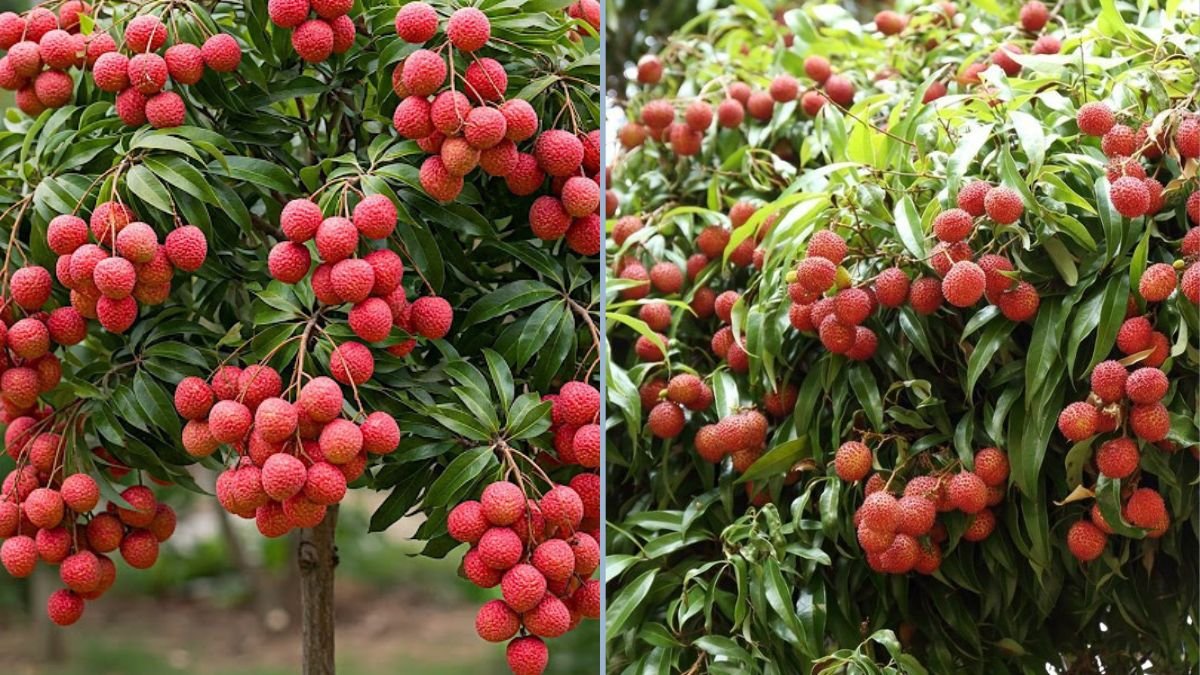Lychee (Litchi chinensis) is a tropical fruit tree cherished for its sweet, juicy, and aromatic fruits. Popular across Asia and other tropical regions, lychee trees not only produce delicious fruits but also add beauty and shade to gardens.
Growing lychee from seeds is possible, but for faster fruiting and reliable quality, vegetative propagation techniques like grafting and air layering are preferred. In this guide, we’ll explore how to grow a lychee plant successfully using these methods, ensuring strong, healthy trees that produce abundant fruits.
1. Why Grow Lychee Plants?
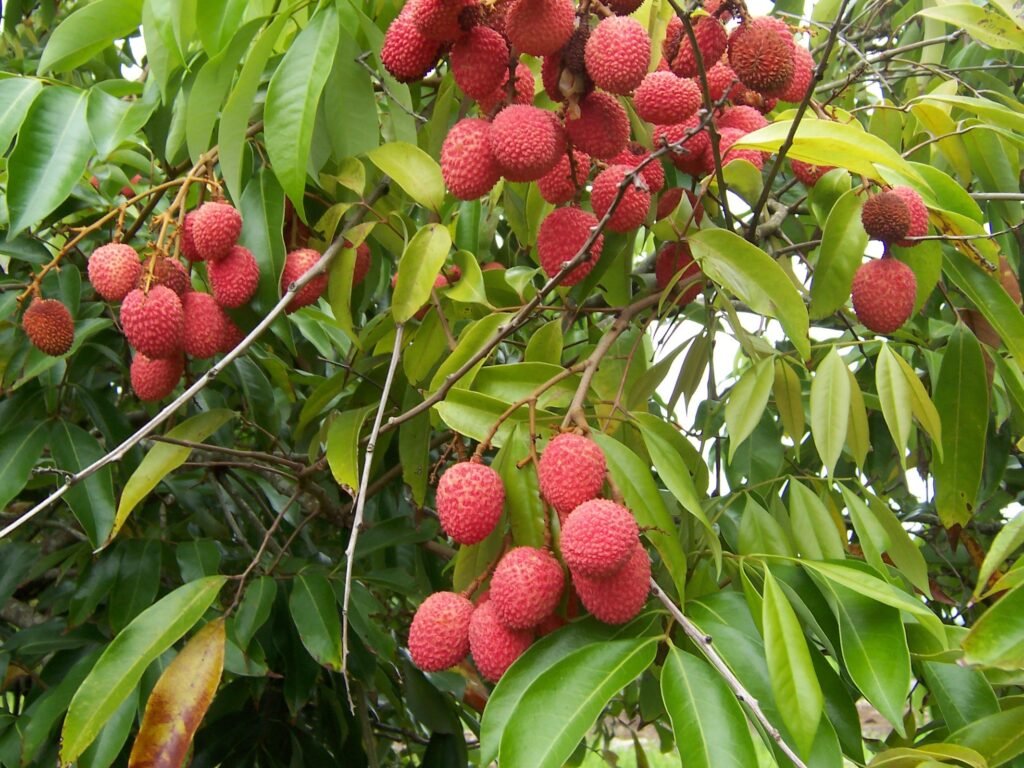
Growing lychee at home or in orchards has several advantages:
- Delicious fruits: Homegrown lychee is sweeter and fresher than store-bought.
- Nutritional value: Rich in vitamin C, antioxidants, and dietary fiber.
- Aesthetic appeal: Evergreen foliage and attractive flowers enhance garden beauty.
- Long-term investment: Lychee trees can produce fruits for decades when well-maintained.
With proper propagation techniques, even small-scale gardeners can enjoy high-quality lychee fruits.
2. Choosing the Right Lychee Variety
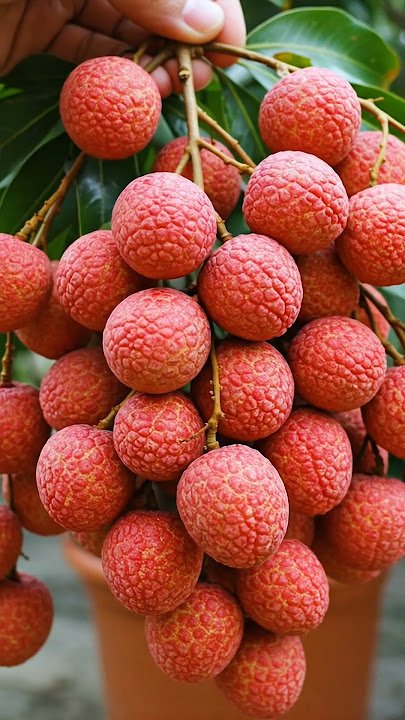
Selecting the right variety ensures better fruit quality, disease resistance, and growth performance. Popular varieties include:
- Shahi: Sweet, large, and easy to grow.
- China Lychee: Smaller fruits but early flowering.
- Brewster: Popular for home gardens due to its reliable yield.
Choose a variety suited to your climate, space, and fruit preference.
3. Propagation Methods: Seeds vs. Vegetative Techniques
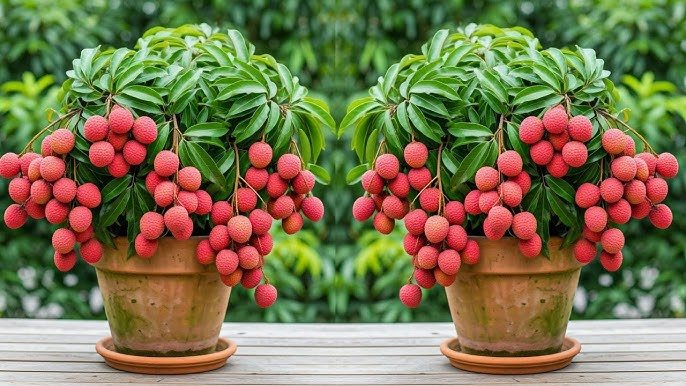
Lychee can be grown from seeds, but vegetative propagation produces faster, uniform fruiting trees.
Seed Propagation:
- Seeds germinate within 2–3 weeks.
- Seed-grown plants take 5–8 years to bear fruit.
- May not retain parent plant characteristics.
Vegetative Propagation (Grafting and Air Layering):
- Produces trees that fruit faster (2–3 years).
- Maintains characteristics of the parent plant.
- Allows cultivation of high-yield, disease-resistant varieties.
For faster fruiting, grafting and air layering are highly recommended.
4. Selecting Healthy Parent Plants
Healthy parent plants ensure successful propagation:
- Choose disease-free, mature trees with good fruit quality.
- Select stems or branches with vigorous growth.
- Avoid weak or damaged plants to maximize success.
A healthy source plant is key to producing strong, productive lychee trees.
5. Grafting Lychee Plants
Grafting is a common method to propagate lychee for uniform fruiting.
Steps for Grafting:
- Select scion and rootstock:
- Scion: Healthy, 1-year-old branch from the desired variety.
- Rootstock: Young, disease-free seedling of compatible variety.
- Prepare the graft:
- Cut the scion and rootstock with matching slanted cuts.
- Ensure a clean cut for maximum cambium contact.
- Join and secure:
- Fit scion and rootstock together.
- Wrap with grafting tape or plastic to protect from drying.
- Aftercare:
- Keep the grafted plant in partial shade initially.
- Water moderately and protect from pests.
- Remove the wrap after 3–4 weeks once the graft has taken.
Grafting ensures a strong, fast-growing tree that produces quality fruits within 2–3 years.
6. Air Layering Lychee Plants
Air layering is another effective method for propagating lychee. It allows root development while still attached to the parent plant, increasing success rates.
Steps for Air Layering:
- Select a branch:
- Choose a healthy, 1-year-old branch with vigorous growth.
- Prepare the branch:
- Remove a 1–2 inch ring of bark (girdling) to expose the cambium.
- Apply rooting hormone powder to the exposed area.
- Wrap with moist medium:
- Cover the girdled area with sphagnum moss or coco peat.
- Wrap with plastic film and secure with string or tape to retain moisture.
- Root development:
- Roots appear within 4–6 weeks.
- Keep moss moist throughout the period.
- Transplanting:
- Once roots are well-developed, cut below the new root system.
- Plant the air-layered branch in a well-prepared pot or garden site.
Air layering produces a high-success, fast-growing lychee plant, ready to fruit sooner than seed-grown trees.
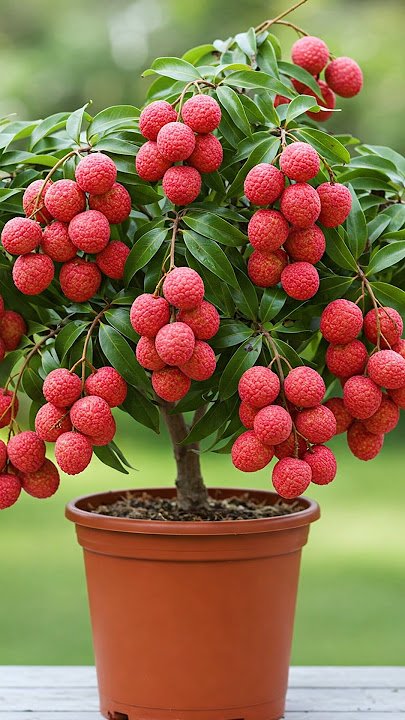
7. Choosing the Right Container or Soil
Whether planting in a pot or garden:
- Container size: Minimum 18–24 inches in diameter and depth for young plants.
- Soil: Well-draining, fertile soil with a mix of garden soil, compost, and sand.
- pH: Slightly acidic to neutral (5.5–6.5) is ideal.
💡 Tip: Good drainage prevents root rot and promotes healthy growth.
8. Sunlight and Temperature Requirements
Lychee is a tropical tree that loves sunlight:
- Sunlight: At least 6–8 hours of direct sunlight daily.
- Temperature: Optimal range is 20–35°C (68–95°F). Protect young plants from frost.
- Air circulation: Adequate airflow reduces fungal infections.
Proper environmental conditions ensure healthy growth, flowering, and fruiting.
9. Watering Lychee Plants
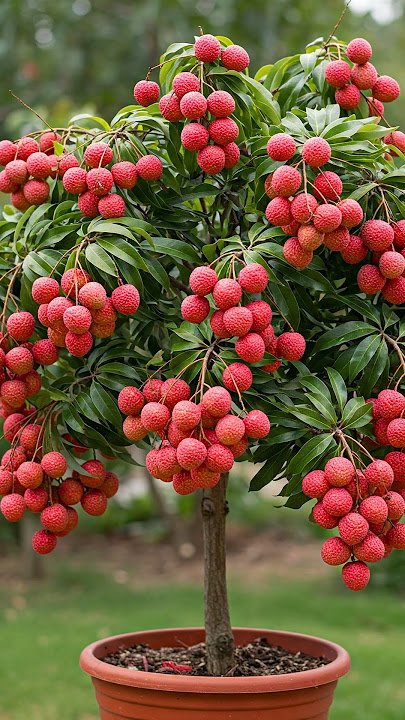
Lychee requires consistent moisture, especially after grafting or air layering:
- Keep soil moist but not waterlogged.
- Water deeply 2–3 times per week during dry periods.
- Reduce watering slightly in winter to prevent root rot.
Consistent watering supports strong roots, healthy leaves, and fruit production.
10. Fertilizing for Healthy Growth and Fruit
Fertilization is key for lychee development:
- Nitrogen-rich fertilizer: Supports vegetative growth.
- Phosphorus and potassium: Encourage flowering and fruiting.
- Organic compost or well-rotted manure: Enhances soil fertility.
- Fertilize every 6–8 weeks during the growing season.
Balanced nutrition ensures vibrant foliage, strong branches, and abundant fruits.
11. Supporting Young Lychee Plants
Young trees may need support:
- Stake young grafted or air-layered plants to maintain upright growth.
- Tie stems loosely to prevent bending or breakage.
- Gradually remove support as the tree strengthens.
Support ensures healthy structure and reduces damage risk.
12. Pruning Lychee Trees
Pruning improves air circulation, light penetration, and fruiting:
- Remove dead, weak, or crowded branches.
- Shape the tree to maintain a manageable size, especially in pots.
- Prune after harvesting to encourage new growth and flower formation.
Well-pruned trees produce higher yields and better-quality fruits.
13. Flowering and Pollination
Lychee produces fragrant flowers that attract pollinators:
- Most varieties are self-fertile, but cross-pollination improves fruit set.
- Bees and other insects enhance natural pollination.
- Hand pollination can be used for indoor or balcony trees.
Proper pollination ensures abundant, uniform fruiting.
14. Harvesting Lychee Fruits
Patience is key — lychee trees usually take 2–3 years to bear fruit after grafting or air layering:
- Fruits are ripe when they turn red or pinkish, depending on the variety.
- Twist or cut fruits carefully to avoid branch damage.
- Harvest regularly to encourage continuous flowering and fruiting.
Homegrown lychee fruits are sweet, juicy, and packed with nutrients, making them ideal for family consumption.
15. Common Pests and Diseases
Lychee plants are relatively hardy but can face:
- Lychee stink bug: Causes fruit damage; remove pests manually or use neem oil.
- Anthracnose and powdery mildew: Avoid water on leaves and ensure proper spacing.
- Fruit flies: Cover fruits with protective bags.
Regular monitoring ensures healthy plants and high-quality fruits.
16. Long-Term Care for Lychee Plants
For sustained growth and productivity:
- Repot container-grown plants every 2–3 years to accommodate root growth.
- Mulch around the base to retain moisture and improve soil fertility.
- Fertilize seasonally to maintain nutrient levels.
- Prune annually to shape the tree and stimulate flowering.
With proper care, lychee trees can produce fruits for decades, providing sweet, juicy fruits year after year.
17. Final Thoughts: Growing Lychee Plants Successfully
Growing lychee is rewarding and enjoyable, especially with grafting and air layering techniques. These methods provide faster fruiting, stronger trees, and consistent fruit quality compared to seed-grown plants.
By selecting healthy parent plants, preparing fertile soil, providing sunlight, water, and proper care, you can grow a thriving lychee tree at home or in your garden. The process allows you to experience the joy of cultivating tropical fruits and enjoy fresh, delicious lychees directly from your own tree.
Lychee propagation through grafting and air layering is the key to success. With patience, attention, and proper techniques, even beginners can enjoy the satisfaction of homegrown lychee fruits that are nutritious, aromatic, and irresistibly sweet.
